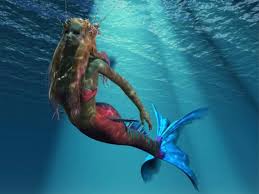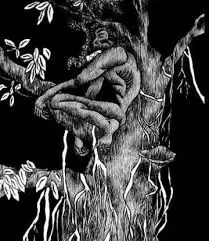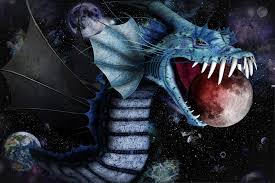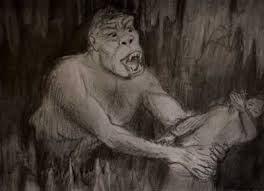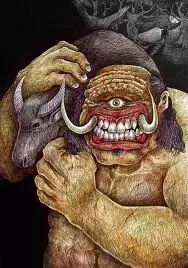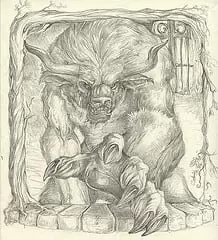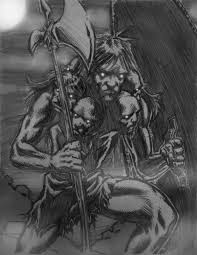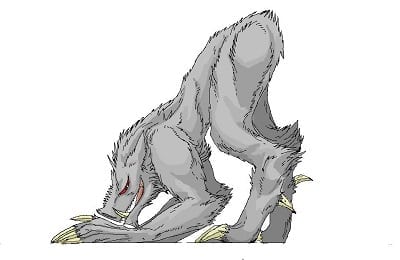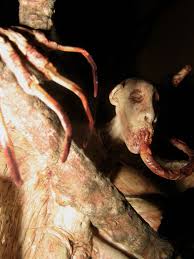10 Lesser-Known Mythical Creatures in Philippine Folklore

Philippine folklore is a treasure trove of strange mythical creatures that have stood the test of time. Just mention the names aswang, encanto, kapre, tikbalang or tiyanak and you’ll get most Filipinos—especially the young ones—turning into scaredy cats.
But before old-school horror stories scare the living daylights out of you, let’s take a look back on some not-so-popular mythical creatures that have made Philippine mythology even more colorful and—of course—horrifying.
10. Pasatsat
Pasatsats are the ghosts of those who died or killed during the Japanese occupation. Poor townspeople of this war era could not afford to buy a coffin so they used pamalisan (reed mat) to cover the dead. And because unscrupulous men at that time desecrate the graves to get gold, shirts, and other loots (Agoncillo 2000, 416), most people were forced to bury their loved ones in places other than the cemetery.
Now, this is probably where the tortured ghosts started to emerge.
The name “pasatsat” actually came from the Pangasinense term “satsat” which means “to stab.”
Pasatsats usually show their ghastly form to some random passersby on the street. In order to get rid of the ghost, the person who saw it will be required to stab (hence, the name) the pamalisan covering the corpse. Mysteriously, this exposes not the actual human remains but a noxious odor that will make anyone puke.
9. Berberoka
More popular in the remote areas of Abra, Apayao and Ilocos Norte, this freshwater ogre uses deceptive tactics to catch its prey. Berberoka sucks water from swamps or lakes until a school of fish is evident in the surface.
The victims–mostly fishermen–will then be lured by the evil’s trap. Berberoka uses the same water it sucked previously to drown and eat the helpless victims.
Also Read: The Most Legendary Gods and Goddesses of Philippine Mythology
This frightening water creature is Philippine’s counterpart of the Greek naiad, a female spirit who inhabits streams, brooks, wells, and other bodies of freshwater.
The graphic novel “Mga Tambay sa Tabi-Tabi“, created by a group of artists known as Kid’s Illustrators, reveals that despite its terrifying reputation, Berberoka has an unusual fear of crabs.
8. Ani-ani
A fusion of aswang and kapre, this mysterious night creature is relatively unknown in Philippine folklore. According to legends, ani-ani is a humanoid that stands about eighteen feet tall and emits a strong, goat-like smell.
Just like the aswang (vampire), ani-ani also possesses the power of shape-shifting: It has the ability to change into various forms ranging from carabao and cow to horse and even pig.
The thing that sets ani-ani apart from the aswang is its diet—they don’t suck blood. Instead, ani-ani are mostly known to block the path of walking travellers and usually seen smoking while sitting on a large tree branch (e.g. talisay)—characteristics that are reminiscent of the traditional kapre.
7. Baconaua/Bakunawa
Bakunawa is another mythical giant that brings with it a fascinating glimpse of how our ancestors dealt with natural phenomena.
Hailed as the god of the underworld, Bakunawa is a half-dragon, half-snake that allegedly appears once or twice in a man’s lifetime to bring eclipse.
Legend has it that this giant sea serpent was enamored by the beauty of the seven moons we had back then. The Bakunawa swallowed the moons and brought darkness on the face of the earth.
Bathala then asked the people to make improvised noise using pots and pans to disturb the sea monster. As a result, Bakunawa was frightened enough to spit out the moons and never return again.
Bakunawa’s origins can be traced back to a Hiligaynon folklore which describes this mythical creature as a giant sea serpent blessed with “a mouth the size of a lake, a red tongue, whiskers, gills, small wires at its sides, and two sets of wings.”
6. Amomongo
Amomongo is a hairy white ape that allegedly lives in a cave at the base of Mt. Kanlaon, Negros Occidental. Using its long, sharp nails, this “Negros ape” disembowels its victims (mostly chickens, goats, and other small animals) and eats their intestines.
READ: Top 10 Unsolved Mysteries in the Philippines
On average, it stands 5 feet and 4 inches tall and described by most crytozoologists as reclusive.
On June 9 and 10, 2008, the closest Amomongo encounter yet happened when Elias Galvez and Salvador Aguilar, two residents of Brgy. Sag-ang, La Castellana, Negros Occidental, were allegedly attacked by a “hairy creature with long nails.” (Coleman 2008)
Just like in the case of the widely popular Bigfoot, the existence of Amomongo is still shrouded in mystery. Some experts say that Amomongo is an albino gorilla but with no species of ape native to the Philippines, it’s harder to confirm, let alone believe, the beast’s real identity.
5. Bungisngis
Bungisngis is the Philippine equivalent of Greek mythology’s Cyclops. This one-eyed monster allegedly inhabited Orion, Bataan where it was known for its unique laugh, hence the name. In fact, “bungisngis” came from the Filipino root word ‘ngisi‘ which means “to giggle.”
But don’t let the name fool you: According to legends, Bungisngis is a cannibal giant with horrifying features to boot. Aside from a single eye on the middle forehead, Bungisngis also have huge upper lips, humongous teeth and two long tusks resembling that of African elephants.
Some Filipino folk tales portray Bungisngis as a dumb giant far less threatening than their Greek/Roman counterparts. But since Philippine mythology is based more on oral traditions than an organized pantheon, Bungisngis was lost to a variety of interpretations.
4. Sarangay
Sarangay is a half-man, half-bull mythical creature of Ibanag origin. It dwells in the wilderness and uses its scary reputation to protect his habitat from invaders.
Apart from its devilish countenance and prominent horns, Sarangay also has sacred jewels hanging in its ears. These gems purportedly possess superpowers and if anyone tries to steal them, the thief is guaranteed of a gory death.
Just like the ordinary bull, Sarangay also emits smoke in its nose when angered.
This bull-headed creature, which joins other demon-like beings in the lower Philippine mythology, is also known as the local folklore’s equivalent of Greek’s Minotaur.
3. Gawigawen
Gawigawen is a fierce, six-headed giant that owns equally gigantic weapons of war. Its origins can be traced back to an original Tingguian story entitled “Gawigawen of Adasen” (1916).
The legend tells the story of Aponibolinayen who fell ill and craved for oranges owned by the giant Gawigawen. His husband, Aponitolau, overheard his wife’s request and decided to go on a long journey to find the oranges.
After facing numerous obstacles and with the help of the chief of the spider, Aponitolau finally reached Gawigawen’s territory. Although he passed the giant’s challenge of eating a whole carabao, Aponitolau eventually died after picking two oranges from the tree made of knives.
Aponitolau’s son, Kanag, decided to fight back after learning about his father’s death. By turning himself into an ant, Kanag escaped the giant’s massive attacks and eventually killed the gargantuan villain.
2. Sigbin
Inarguably the local version of Latin America’s chupacabra, sigbin has varying descriptions linked to its name. Some folk tales depict sigbin as a wild animal with a size of a small bear and a row of spines embedded from neck to tail.
A more popular story, however, portrays sigbins as hornless goats that look like small kangaroos. This creature possesses flapping ears, burning eyes, whip-like tail, and the ability to walk backward.
Although most people regard sigbins as part of urban legends, eye-witness accounts from various parts of the country seem to prove otherwise. In a news report published by the Philippine Daily Inquirer dated January 14, 2008, some residents of Roxas City, Capiz claimed that their animals were killed by a bizarre, blood-sucking monster.
Jojo Canobida, a resident of Sitio Paon of Dumolog, said that he saw a dog-like creature running away in lighting speed after killing some of his chickens. Most of the animal victims were found either headless or with deep puncture marks in the neck—bloods all sucked out.
Experts, however, claim that sigbins could be one of the new cat-fox species recently discovered in the Indonesian island of Borneo.
1. Bal Bal
Bal Bal is a scavenger-monster with a voracious appetite for dead human bodies. Also known as maninilong among the natives of Catanauan, Quezon, this vampire-like creature prefers to prey on corpses. With long, razor-sharp claws and a sense of smell that may be 10x more sensitive than dogs’, Bal Bal easily find its next meal on cemeteries and even funerals.
Aside from their obnoxious breath, Bal Bal also have a unique power of hypnosis that is used to make people (i.e. those in the funeral) sleep while the monster feeds on its prey. To deceive people, Bal Bal replaces the corpse with banana trunk resembling the deceased.
Works Cited
Agoncillo, Teodoro. History of the Filipino People. Quezon City: C & E Pub., 1990.
Coleman, Loren. “Amomongo Hominoid Terrorizes Philippines.” 2008. http://tinyurl.com/auh3mst (accessed 7 Feb 2013).
Feature image courtesy of blog.easytobook.com
FilipiKnow
FilipiKnow strives to ensure each article published on this website is as accurate and reliable as possible. We invite you, our reader, to take part in our mission to provide free, high-quality information for every Juan. If you think this article needs improvement, or if you have suggestions on how we can better achieve our goals, let us know by sending a message to admin at filipiknow dot net
Copyright Notice
All materials contained on this site are protected by the Republic of the Philippines copyright law and may not be reproduced, distributed, transmitted, displayed, published, or broadcast without the prior written permission of filipiknow.net or in the case of third party materials, the owner of that content. You may not alter or remove any trademark, copyright, or other notice from copies of the content. Be warned that we have already reported and helped terminate several websites and YouTube channels for blatantly stealing our content. If you wish to use filipiknow.net content for commercial purposes, such as for content syndication, etc., please contact us at legal(at)filipiknow(dot)net


